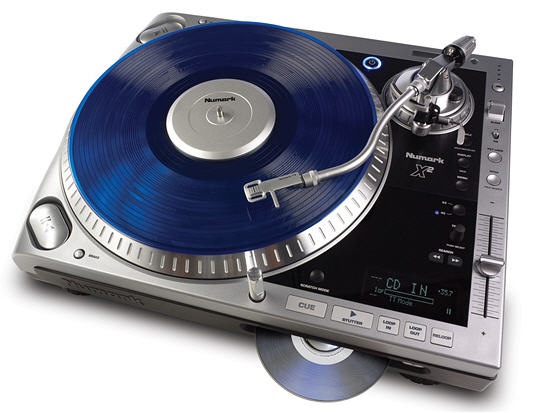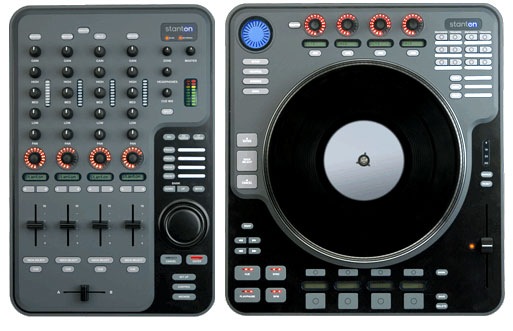
Since this week has become Unplanned Unofficial Vinyl Week, I might as well keep going. Vinyl with printed timecode is just one path. Here are two examples (one recent, one upcoming) of products that have found other means of connecting digital sound to the turntable. If a product like Traktor Scratch or Serato Scratch Live represent the maturation of the integrated vinyl + hardware + software solution, these two tools virtualize the turntable experience in other ways. And they demonstrate just how much control technology can change in music, turntable or no.
The Numark X2, above, as pointed out by beatfix in comments, is a hybrid of two approaches. It’s a conventional turntable (meaning you can actually hook it up to an amp and hear something, which isn’t the case with timecode-encoded vinyl). But it also uses the turntable to manipulate an MP3 CD. Now, obviously, Numark has missed the obvious next step: why not transmit control data to a computer instead of a CD? The X2, with a street well below US$1000, isn’t new; it’s been around a couple of years. But I’m still waiting for the concept to be applied to a computer output. (Anyone?)

In the opposite direction, the Stanton Control System, unveiled at NAMM in January and due to ship in June, does away with the turntable. The deck, the SCS.1d, simulates the feel of a turntable with a high-torque motorized platter and even a motorized pitch fader. Personally, I love this — and think it could be a sign of other, non-DJ controllers with tactile feedback. (You heard it here first. Uh … but I do expect that to take a while, as tactile control design is hard.)
But the turntable has some control features of its own: trigger pads, LCD scribble strips, encoders, transport controls, and preset triggers and navigation keys. They look a little odd, honestly, on a faux turntable, but it does save some space and gear.
The SCS.1m on left is a traditional mixer control surface with LCD "scribble strips" (reminds me a bit of the Novation keyboards) and endless encoders with a light-up ring (as we’ve been seeing various places.) The mixer controller is also a FireWire audio interface with mic and phono ins and dedicated headphone out, plus a footswitch input. That might win the hearts of some Ableton Live users who aren’t necessarily DJs.
This answers what Stanton has been doing post-FinalScratch. With that system defunct, what the Control System does is get you into whatever software you happen to choose. It works with Traktor Studio (the non-Scratch version of Traktor), Ableton Live, Deckadance, and MixVibes.
Cost: US$1499 for the deck, $999 for the mixer. And you can see the problem — a real turntable might be cheaper. But then, given what DJs make… hey, even a few VJ gigs might make it worth it if you really wanted it.
Part of why I find all of this interesting, even without being in the market for such a device myself, is what it says about controllers. The DJ market ought to be fairly predictable at this point, theoretically. And yet here are two examples of products that suggest that even conventional DJing, with a pre-defined set of basic techniques and hardware, can become unpredictable with the addition of a computer. As people struggle to define what a controller might look like for a laptop artist or musician using software like Ableton Live, I think the possibilities become even more wide open.
But then, that’s the fun of it.
I just want to see more high-torque motors in stuff.